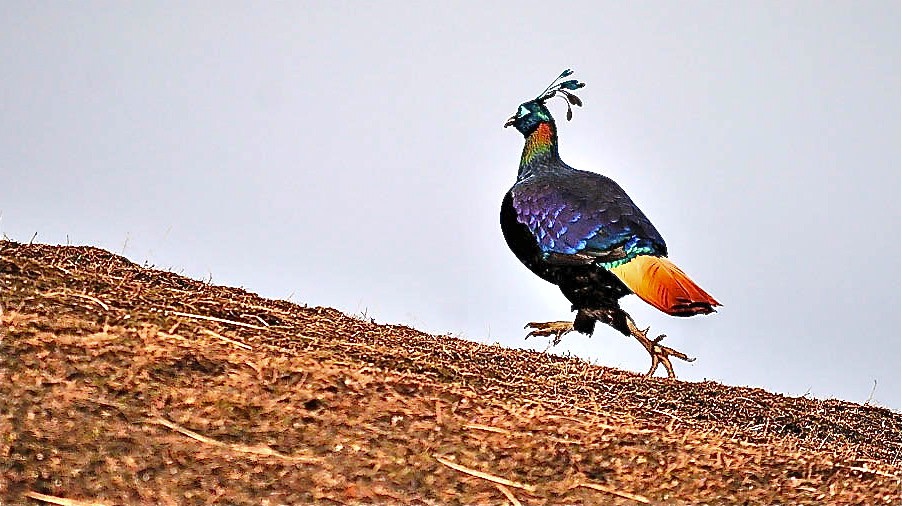Himalayan Monal
A species of Monals, Also known as Impeyan Scientific name : Lophophorus impejanus Genus : Monals
Himalayan Monal, A species of Monals
Also known as:
Impeyan
Botanical name: Lophophorus impejanus
Genus: Monals
Content
Description General Info
Description
It is a relatively large-sized pheasant. The bird is about 70 cm (28 in) long. The male weighs up to 2,380 g (84 oz) and the female 2,150 g (76 oz). The adult male has multicoloured plumage throughout, while the female, as in other pheasants, is more subdued in colour. Notable features in the male include a long, metallic green crest, coppery feathers on the back and neck, and a prominent white rump that is most visible when the bird is in flight. The tail feathers of the male are uniformly rufous, becoming darker towards the tips, whereas the lower tail coverts of females are white, barred with black and red. The female has a prominent white patch on the throat and a white strip on the tail. The first-year male and the juvenile resemble the female, but the first-year male is larger and the juvenile is less distinctly marked. 
Size
72 cm
Colors
Brown
Black
Green
Yellow
Gray
Blue
Orange
Purple
Life Expectancy
10-12 years
Nest Placement
Ground
Feeding Habits
Himalayan Monal primarily consumes seeds, tubers, shoots, and berries. This adaptable feeder also preys on insects, larvae, and assorted vegetable matter. In Tibet, himalayan Monal uniquely forages for highland barley, tsampa, and ghee at monasteries. The bird's feeding behavior is characterized by foraging on the ground.
Habitat
Himalayan Monal typically resides in open coniferous or mixed forests, often featuring an understorey of rhododendron and bamboo, and is adapted to steep valley terrains. These birds are also found in areas with human cultivation, as well as in meadows and clearings. Himalayan Monal demonstrates altitudinal migration, occupying higher elevations above the treeline during the summer months and descending to lower altitudes in the winter, as low as 2500 meters. Their habitat range primarily spans elevations between 2100 to 4500 meters.
Dite type
Herbivorous
General Info
Feeding Habits
Bird food type
Behavior
The breeding season is April through August, and they generally form pairs at this time. In winter they congregate in large coveys and roost communally. 
Distribution Area
The Himalayan monal's native range extends from Afghanistan and Pakistan through the Himalayas in India, Nepal, southern Tibet, and Bhutan. In Pakistan, it is most common in the Khyber Pakhtunkhwa province and has also been recorded in Kaghan, Palas Valley, and Azad Kashmir. It lives in upper temperate oak-conifer forests interspersed with open grassy slopes, cliffs and alpine meadows between 2400 and 4500 meters, where it is most common between 2700 and 3700 meters. It descends to 2,000 m (6,600 ft) in the winter. It tolerates snow and digs through it to obtain plant roots and invertebrate prey. 
Species Status
In some areas, the species is threatened due to poaching and other anthropogenic factors. In the western Himalayas, the local monal population responded negatively to human disturbance involving hydroelectric power development. The male monal was under hunting pressure in Himachal Pradesh, where the crest feather was used to decorate men's hats, until 1982, when hunting was banned in the state. The pheasant is not considered endangered in Pakistan and can be easily located. In some areas, the population density of the species is as high as five pairs per square mile. The main threat to the species is poaching, as the crest is valuable. It is thought to bring status to its wearer and is a symbol of authority. 
